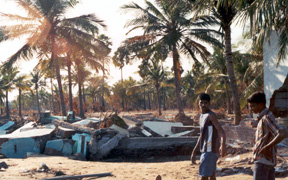 |
Young fishermen walk through the rubble in the village at Muthukadu, Chennai, India. Photos courtesy of K.C. Balaji. |
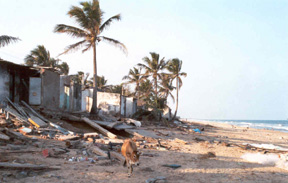 |
Villagers said the animals were very restless before the waves struck. |
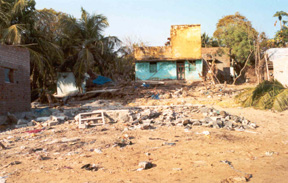 |
His 2-year-old daughter and 7-year-old son built sand castles, played ball and dodged waves as they lapped the shore.
One week later, a deadly tsunami struck the tranquil beach, erasing everything in its path.
“It’s too close to call,” said Dr. Balaji, director of Urological Oncology Research and associate professor of urological surgery at UNMC. “My wife heard that there were two children washed away where we were. It could have struck anytime.”
Although Dr. Balaji grew up on the sandy shores of the Bay of Bengal, off the Indian Ocean, he wasn’t familiar with tsunamis, giant waves caused by an underwater disturbance. “I’d never heard of it,” he said. “We never knew that such a phenomenon was possible.”
But, on Dec. 26, the lives of hundreds of thousands of south Asians were forever changed when a monster earthquake sent walls of water crashing across a dozen countries.
That day, Dr. Balaji and his family were about 5 miles inland in his hometown of Chennai, capitol of Tamil Nadu, when they heard reports that the beaches had flooded. “We initially underestimated the impact,” he said.
Chennai, which has a population of about 10 million people, was generally unaffected by the giant waves, Dr. Balaji said. Most of the damage was done to the villages right on the sea. However, one week before the tsunami struck, the family had stayed at a beach resort, where Dr. Balaji attended a medical school class reunion.
“The damage is unbelievable,” he said. “Those on the beach were badly affected and hundreds were washed away.” He is grateful that his friends and family were not harmed.
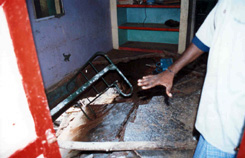 |
Many of the fisherman families affected by the tragedy live in single-room houses such as this one. |
Dr. Balaji saw some of the devastation first-hand when he traveled to a fisherman’s coastal village, near the family’s coconut and mango farm. The one-acre farm, located about one mile inland, was not affected, but the village of Karikattukuppam was heavily damaged. There, the tsunami destroyed homes, lives and livelihoods. Fishing nets were swept out to sea. Catamarans were ripped apart. Beaches were littered with debris. The powerful surge even shattered the concrete foundation of a home.
“And this is an area that is considered not terribly affected,” he said.
The disaster gave Dr. Balaji a new appreciation for the power of nature. “To penetrate a concrete foundation takes an unbelievable force of water,” he said. “I have a lot of respect for Mother Nature and realize how precious it is to have what we have.”
That’s why Dr. Balaji would like to help the 300 to 400 villagers in Karikattukuppam, about 200 meters from the sea, rebuild their lives. “It would mean so much if we could help one village at a time get back on its feet,” he said.
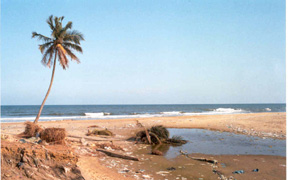 |
Debris litters the once-pristine, sandy beach. |
“The dignity and courage with which the affected people deal with this tragedy impressed me,” Dr. Balaji said. “So many lost everything, but most of all they want boats for their livelihood. Helping one village is a tiny drop in the ocean, but it’s something we can try to do as a community.”